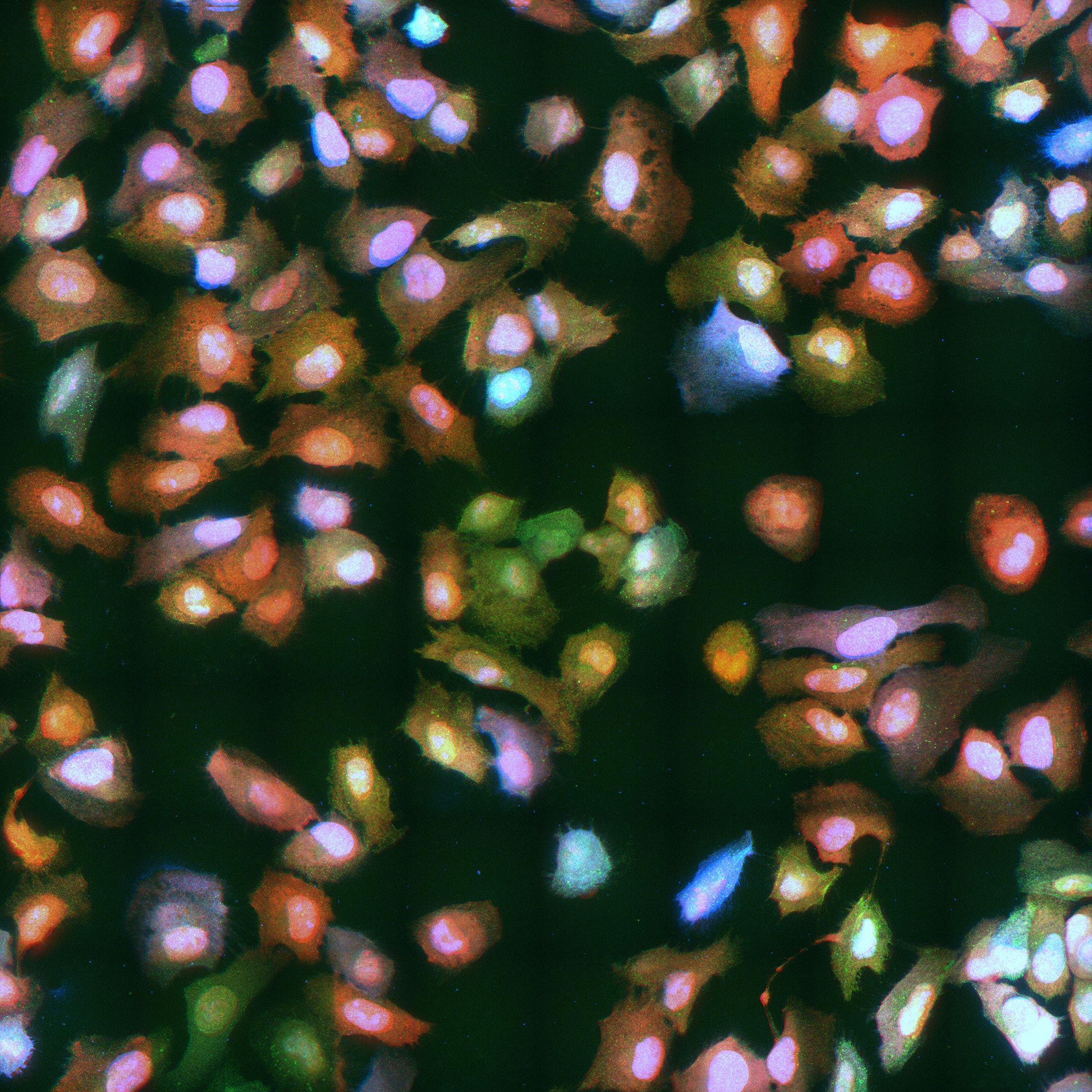Live capture of virus infected cells. After a host cell has been infected, a virus tries to replicate (green dots) and to prevent the host cell from interfering with virus replication by attacking the host cell’s nucleus (blue) and switching off the host cell’s protein production (red)). Photo credit: Sanne Boersma © Hubrecht Institute
Researchers from the Hubrecht Institute and the University of Utrecht developed an advanced technique that can be used to monitor a virus infection live. Researchers from Marvin Tanenbaum and Frank van Kuppeveld’s groups expect the technique to be used to study a wide variety of viruses, including SARS-CoV-2 – the virus responsible for the current pandemic. The technique known as VIRIM (“real-time imaging for viral infections”) is therefore very valuable for gaining insight into viral infections in the human body. This can ultimately lead to more targeted treatments for viral infections. The results were published in the leading journal Cell on November 13th.
Viruses have a great negative impact on society. This once again shows the enormous consequences of the current global SARS-CoV-2 outbreak for our physical and mental health as well as for the economy.
intruder
RNA-Viruses are a large group of viruses that carry their genetic information in the form of RNA: a molecule that is similar DNA, the genetic material of humans. After infecting a host cell, an RNA virus hijacks many functions of the host cell and turns it into a virus-producing factory. This allows the intruder to quickly replicate in cells in the body. The new virus particles are then released through the airways and can infect other people. Examples of RNA viruses include coronaviruses, hepatitis C virus, Zika virus, and enteroviruses – a group of viruses that include rhinoviruses that cause colds, coxsackieviruses, which are a major cause of viral meningitis and encephalitis, and the poliovirus. that causes paralytic poliomyelitis.
When a host cell is infected, only a single viral RNA molecule is present (point at the start of infection). During replication, the virus replicates the RNA molecule (increase in spots). VIRIM (Virus Infection Real-Time Imaging) enables replication to be analyzed right from the start of the infection. Photo credit: Sanne Boersma © Hubrecht Institute
Live broadcast
So far, the available techniques could only provide a snapshot of virus-infected cells. In other words, researchers were able to see the infected cells at a specific point in time, but were unable to monitor the process of viral infection from start to finish. The newly developed microscope technology VIRIM (‘Virus Infection Real-Time Imaging’) changes the following: Researchers from the groups Marvin Tanenbaum (Hubrecht) and Frank van Kuppeveld (University of Utrecht) developed this advanced method with which the entire course of a virus infection can be followed in Laboratory can be visualized with great precision. “With this new method, we can answer many important questions about viruses,” says Sanne Boersma, first author of the study.
Fluorescent virus
The method uses SunTag – a technology previously developed by Tanenbaum – in an enterovirus, a group of viruses in which Van Kuppeveld has extensive expertise. The SunTag is introduced into the RNA of the virus and marks viral proteins with a very bright fluorescent tag. With this fluorescent tag, viral proteins can be seen with a microscope, so researchers can see when, where and how quickly a virus is producing proteins and replicating in its host cell. VIRIM is much more sensitive than other methods: protein production from a single viral RNA can be detected. This allows researchers to follow the course of the infection from the start.
When a host cell is infected, only a single viral RNA molecule is present (point at the start of infection). The virus cannot replicate in this host cell because no increase in spots can be detected. Photo credit: Sanne Boersma © Hubrecht Institute
competition
The building blocks of our body – cells – have their own defense system to recognize and eliminate a virus when infected. As soon as a virus enters a cell, competition arises between the virus and the host cell: the virus tries to hijack the cell in order to replicate itself, while the host tries very hard to prevent it. With VIRIM, the researchers could see the result of this competition. They found that in a subset of cells, the host cell won the competition. Boersma: “These host cells were infected with a virus, but the virus could not replicate.” This sparked the curiosity of Boersma and her colleagues and led to a new experiment.
Achilles heel of the virus
The researchers helped host cells by strengthening their immune system. It turned out that the very first virus replication in the cells that received the boost often failed, preventing the virus from taking over the host. “The first step in the replication process is the Achilles’ heel of this virus: This moment determines whether the virus can spread further,” explains Boersma. “If the host cell fails to eliminate the virus at the beginning of an infection, the virus will replicate and win the competition.” Boersma and her colleagues used a picorna virus to develop VIRIM. Members of this family of viruses can cause illnesses ranging from the common cold to serious illnesses like polio.
Wide range of viruses
VIRIM enables the vulnerability of a wide variety of viruses to be identified. Researchers expect the technique to be valuable for research into many life-threatening viruses, including SARS-CoV-2. Boersma explains, “If we understand how viruses replicate and spread, we can pinpoint the Achilles’ heel of a virus. This knowledge can help develop treatments, such as a treatment that intervenes at a vulnerable moment in the life of the virus. This will allow us to develop more efficient therapies and, hopefully, mitigate the effects of viruses on society. ”
Reference: “Translational and Replication Dynamics of Individual RNA Viruses” by Sanne Boersma, Huib H. Rabouw, Lucas JM Bruurs, Tonja Pavlovic, Arno LW van Vliet, Joep Beumer, Hans Clevers, Frank JM van Kuppeveld and Marvin E. Tanenbaum, 13 November 2020, cell.
DOI: 10.1016 / j.cell / 2020.10.019



